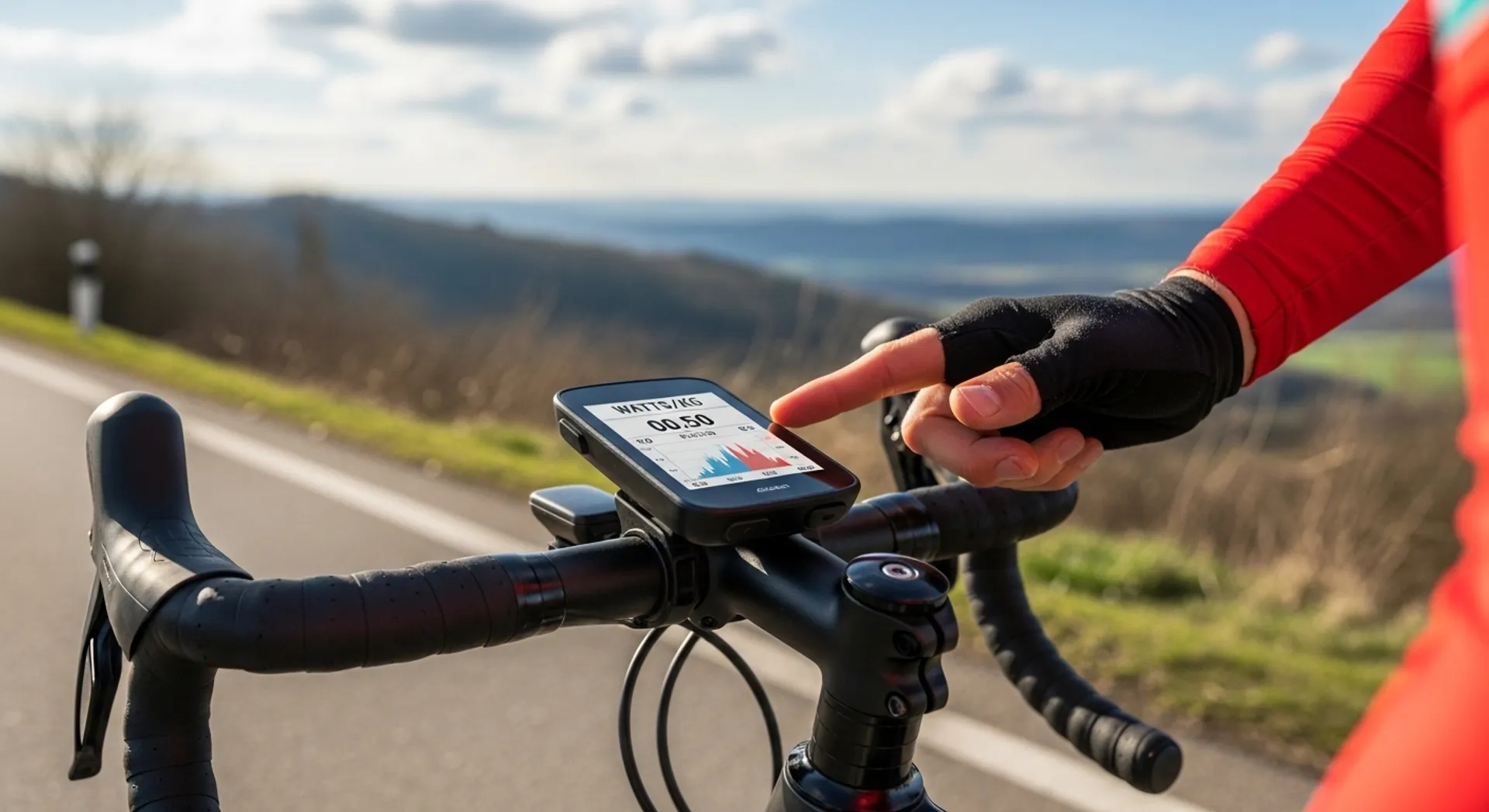Once you’ve completed your fitness test and determined your functional threshold power (FTP), you’re ready to move beyond testing and into the exciting phase of actually improving your cycling fitness. The data you’ve collected isn’t just numbers on a screen — it’s a personalized roadmap that reveals exactly where you are now and points toward the most effective path for improvement.
This is the eighth entry in our comprehensive 15-part series on “Fast Fitness with Power.” If you missed previous entries about setting up and running the fitness test on your power meter or how to prepare your body for a fitness test, I encourage you to go back and read those foundational articles. Each piece builds on the previous one, creating a complete system for understanding and improving your cycling performance through power-based training.
The beauty of power meter training lies in its objectivity and precision. Unlike training based solely on perceived exertion or heart rate, power output provides unfiltered, real-time feedback about your actual work rate. This eliminates guesswork and allows you to train at precisely the right intensity to trigger specific physiological adaptations. But first, you need to understand what your fitness test results are telling you and how to translate those numbers into an effective training strategy.
Understanding Your Fitness Test Results
Power meters calculate fitness levels based on two critical factors that, when combined, provide a complete picture of your cycling performance potential. First is the average watts you sustained during your 20-minute fitness test — this represents your raw power production capacity. Second is your body weight, measured in kilograms. These two numbers combine to create your watts per kilogram (w/kg) ratio, which is the single most important metric for understanding your cycling fitness level.
Why does the w/kg ratio matter so much? Because cycling performance isn’t determined by absolute power alone. A rider producing 300 watts sounds impressive, but if they weigh 100 kilograms, their w/kg ratio is only 3.0. Meanwhile, a rider producing 240 watts but weighing only 60 kilograms has a w/kg ratio of 4.0 — and will climb hills significantly faster despite producing less absolute power. Gravity doesn’t care about your total watts; it cares about your power relative to the weight you’re carrying uphill.
Most power meters with built-in preprogrammed workouts base their training recommendations on similar factors. The iBike power meter system, like other quality training platforms, uses your fitness test results to create personalized workout prescriptions that target your specific needs and opportunities for improvement.
Interpreting Your Numbers
Let’s put some context around typical fitness test results to help you understand where you stand. For recreational male cyclists, average FTP values typically range from 200-250 watts. For recreational female cyclists, typical FTP values range from 150-200 watts. These are broad generalizations — individual results vary widely based on training history, genetics, age, and body composition.
Your w/kg ratio provides even more insight into your performance level. Here are general benchmarks for male cyclists: Below 2.0 w/kg indicates beginner or untrained fitness. 2.0-2.5 w/kg represents recreational fitness. 2.5-3.0 w/kg indicates regular training and solid fitness. 3.0-4.0 w/kg represents competitive amateur fitness. Above 4.0 w/kg indicates advanced or professional-level fitness.
For female cyclists, these benchmarks adjust slightly lower: Below 1.8 w/kg indicates beginner fitness. 1.8-2.2 w/kg represents recreational fitness. 2.2-2.7 w/kg indicates regular training. 2.7-3.5 w/kg represents competitive fitness. Above 3.5 w/kg indicates advanced or professional-level fitness.
Remember that these are guidelines, not judgments. Everyone starts somewhere, and the beauty of power-based training is that it provides a clear path for improvement regardless of your starting point. The key is identifying which specific aspect of your fitness — power production, body weight, or cardiovascular efficiency — offers the greatest opportunity for rapid improvement.
Three Pathways to Improved Fitness
By analyzing your fitness test score, specifically your w/kg ratio and its components, you can zero in on the fitness improvement strategy that will work best for your individual situation. There are three primary pathways to improving your w/kg ratio, and choosing the right one makes the difference between efficient progress and spinning your wheels.
Pathway One: Weight Loss for Typical Power, Heavy Weight
Average wattage measurements of 200 watts are not unusual for recreational cyclists. If your fitness test reveals that your average watts fall in a typical range but your body weight is higher than optimal, then concentrating on weight loss becomes your most effective strategy for rapid fitness improvement.
Consider this example: A male cyclist who sustained 210 watts during his fitness test and weighs 90 kilograms has a w/kg ratio of 2.33 — solidly in the recreational range. If this same cyclist loses 10 kilograms of body weight through proper nutrition and training while maintaining the same power output, his w/kg ratio jumps to 2.63. That’s a 13% improvement in climbing performance without producing a single additional watt of power.
The math behind weight loss is compelling for cyclists carrying excess body fat. Every kilogram lost directly improves your w/kg ratio without requiring any increase in fitness or strength. On climbs, this translates to noticeably faster speeds. On flat roads, reduced weight means less rolling resistance and slightly improved acceleration. The benefits compound across every aspect of cycling performance.
However — and this is critical — weight loss must be approached intelligently to avoid losing muscle mass along with fat. Crash dieting or excessive calorie restriction will cause your body to break down muscle tissue for energy, which actually decreases your power production. The goal is losing fat while preserving or even building muscle, which requires a moderate caloric deficit combined with adequate protein intake and proper training stimulus.
Pathway Two: Strength Building for Low Power, Reasonable Weight
If your body weight is reasonable for your height and build but your wattage during the fitness test was lower than typical, then concentrating on strength improvement will help you achieve the fastest fitness gains. This pathway focuses on increasing your power production capacity through targeted training that develops both muscular and neuromuscular adaptations.
Consider this example: A female cyclist who weighs 60 kilograms (reasonable for her height) but only sustained 120 watts during her fitness test has a w/kg ratio of 2.0 — indicating beginner-level fitness. If she increases her sustainable power to 150 watts through focused strength training while maintaining the same body weight, her w/kg ratio improves to 2.5. That’s a 25% improvement in performance purely through building power.
Strength-focused training for cyclists involves more than just lifting weights in the gym (though resistance training certainly helps). It includes on-bike workouts that specifically target your ability to produce high power outputs: short, intense intervals at 120-150% of FTP, hill repeats that force maximal power production, and progressive overload training that gradually increases the demands placed on your muscular system.
The neuromuscular system — the connection between your brain and muscles — also plays a crucial role in power production. Through repeated high-intensity efforts, your nervous system becomes more efficient at recruiting muscle fibers and coordinating contractions. This neural adaptation allows you to produce more power without necessarily increasing muscle size, which is ideal for endurance cycling where excessive muscle mass would increase body weight.
Pathway Three: Cardiovascular Development for Overall Energy
If you find yourself feeling generally fatigued, lacking energy, or unable to sustain efforts for extended durations, then a cardiovascular-focused approach will help you build your overall fitness to better levels. This pathway emphasizes developing your aerobic engine — the cardiorespiratory system that delivers oxygen to working muscles and clears metabolic waste products.
Cardiovascular fitness forms the foundation of all endurance performance. Your heart’s ability to pump blood, your lungs’ capacity to exchange oxygen, your blood vessels’ efficiency in delivering nutrients, and your muscles’ capability to utilize oxygen all determine how much work you can sustain over long durations. Improving this system creates the platform upon which all other fitness improvements are built.
This pathway is particularly important for cyclists returning to training after a layoff, older athletes experiencing age-related cardiovascular decline, or anyone who feels disproportionately fatigued during rides compared to their power output. While your FTP might seem reasonable on paper, if you can barely complete an hour-long ride without feeling exhausted, your cardiovascular system needs focused development.
Cardiovascular-focused training emphasizes longer, steadier efforts at moderate intensities — typically 60-75% of your FTP. These workouts feel comfortable during execution but accumulate significant training stimulus over time. They increase mitochondrial density in muscle cells, improve capillary networks, enhance fat metabolism efficiency, and expand overall aerobic capacity. The result is greater endurance, faster recovery between efforts, and the ability to sustain higher workloads without excessive fatigue.
Targeted Training Strategies for Each Pathway
Understanding which pathway offers your greatest opportunity for improvement is only the first step. Now you need specific training strategies and workout structures that target your identified weakness and trigger the desired adaptations. Let’s explore the practical implementation of each approach.
Weight Loss Training Protocol
For cyclists focusing on weight loss, the training approach requires balancing several competing objectives: maintaining or building power, creating a caloric deficit, preserving muscle mass, and avoiding the fatigue that undermines workout quality. The preprogrammed workouts in quality power meters typically include “fat burning” zones designed specifically for this purpose.
Fat burning workouts operate at moderate intensities — typically 55-70% of your FTP — for extended durations of 60-90 minutes or more. At these intensities, your body preferentially burns fat for fuel rather than carbohydrates, which is exactly what you want for body composition improvement. These workouts also create substantial caloric expenditure without generating the deep fatigue that comes from high-intensity training.
A typical weekly training plan for weight loss might include: Three to four moderate-intensity fat burning rides of 60-90 minutes at 55-70% FTP. One slightly higher-intensity tempo ride of 45-60 minutes at 75-85% FTP to maintain power production. One shorter, high-intensity interval session to preserve neuromuscular function. Two rest days for recovery.
Nutrition timing becomes critical when training for weight loss. You want to create a moderate caloric deficit overall — typically 300-500 calories below your daily expenditure — but you need adequate fuel around workouts to maintain training quality. Consider eating your normal breakfast before morning rides, keeping calories moderate du




